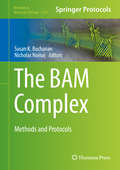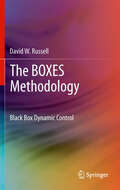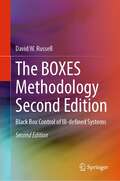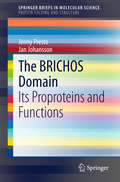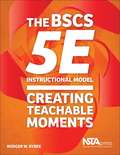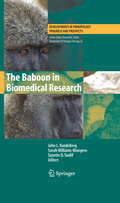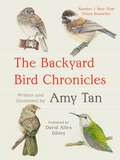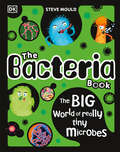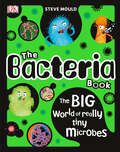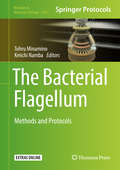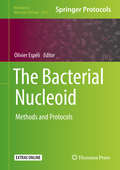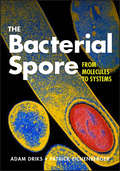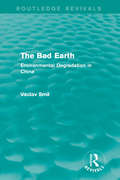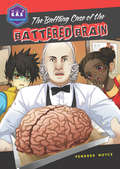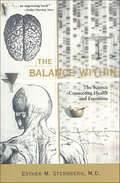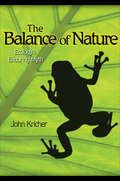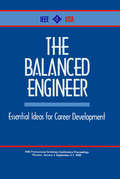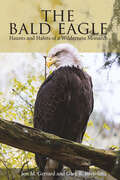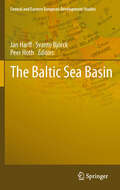- Table View
- List View
The BAM Complex
by Susan K. Buchanan Nicholas NoinajThis volume is comprised of a collection of experimental protocols for common techniques and strategies used to study the biogenesis of b-barrel outer membrane proteins in Gram-negative bacteria. The BAM Complex: Methods and Protocols guides readers through methods on the function of the BAM complex, the roles played by each of the individual components, the expression and purification of the components, crystallization and structure determination of the components, and how the individual Bam components may assemble into a functional complex. Written in the highly successful Methods in Molecular Biology series format, chapters include introductions to their respective topics, lists of the necessary materials and reagents, step-by-step, readily reproducible laboratory protocols, and tips on troubleshooting and avoiding known pitfalls. Authoritative and cutting-edge, The BAM Complex: Methods and Protocols will serve as an invaluable reference for those interested in studying the BAM complex.
The BCS-BEC Crossover and the Unitary Fermi Gas
by Wilhelm ZwergerRecent experimental and theoretical progress has elucidated the tunable crossover, in ultracold Fermi gases, from BCS-type superconductors to BEC-type superfluids. The BCS-BEC Crossover and the Unitary Fermi Gas is a collaborative effort by leading international experts to provide an up-to-date introduction and a comprehensive overview of current research in this fast-moving field. It is now understood that the unitary regime that lies right in the middle of the crossover has remarkable universal properties, arising from scale invariance, and has connections with fields as diverse as nuclear physics and string theory. This volume will serve as a first point of reference for active researchers in the field, and will benefit the many non-specialists and graduate students who require a self-contained, approachable exposition of the subject matter.
The BOXES Methodology
by David W. RussellRobust control mechanisms customarily require knowledge of the system's describing equations which may be of the high order differential type. In order to produce these equations, mathematical models can often be derived and correlated with measured dynamic behavior. There are two flaws in this approach one is the level of inexactness introduced by linearizations and the other when no model is apparent. Several years ago a new genre of control systems came to light that are much less dependent on differential models such as fuzzy logic and genetic algorithms. Both of these soft computing solutions require quite considerable a priori system knowledge to create a control scheme and sometimes complicated training program before they can be implemented in a real world dynamic system. Michie and Chambers' BOXES methodology created a black box system that was designed to control a mechanically unstable system with very little a priori system knowledge, linearization or approximation. All the method needed was some notion of maximum and minimum values for the state variables and a set of boundaries that divided each variable into an integer state number. The BOXES Methodology applies the method to a variety of systems including continuous and chaotic dynamic systems, and discusses how it may be possible to create a generic control method that is self organizing and adaptive that learns with the assistance of near neighbouring states. The BOXES Methodology introduces students at the undergraduate and master's level to black box dynamic system control , and gives lecturers access to background materials that can be used in their courses in support of student research and classroom presentations in novel control systems and real-time applications of artificial intelligence. Designers are provided with a novel method of optimization and controller design when the equations of a system are difficult or unknown. Researchers interested in artificial intelligence (AI) research and models of the brain and practitioners from other areas of biology and technology are given an insight into how AI software can be written and adapted to operate in real-time.
The BOXES Methodology Second Edition: Black Box Control of Ill-defined Systems
by David W. RussellThis book focuses on how the BOXES Methodology, which is based on the work of Donald Michie, is applied to ill-defined real-time control systems with minimal a priori knowledge of the system. The method is applied to a variety of systems including the familiar pole and cart. This second edition includes a new section that covers some further observations and thoughts, problems, and evolutionary extensions that the reader will find useful in their own implementation of the method. This second edition includes a new section on how to handle jittering about a system boundary which in turn causes replicated run times to become part of the learning mechanism. It also addresses the aging of data values using a forgetfulness factor that causes wrong values of merit to be calculated. Another question that is addressed is “Should a BOXES cell ever be considered fully trained and, if so, excluded from further dynamic updates”. Finally, it expands on how system boundaries may be shifted using data from many runs using an evolutionary paradigm.
The BRICHOS Domain
by Jenny Presto Jan JohanssonThis Brief summarizes the current research on the novel BRICHOS domain, which is a chaperone domain found in a variety of proteins and is shown to exhibit anti-amyloidogenic chaperone-like functions. The BRICHOS domain is defined from sequence similarities, lacks established physiological function(s) and is found about 10 distantly related pro-protein families, several of which are associated with human disease. In this work, the authors review the mechanism by which BRICHOS inhibits Aβ aggregation and examine recent results from in vivo experiments where BRICHOS inhibits Aβ aggregation and toxicity in Drosophila melanogaster. BRICHOS is one of nature´s (more specific) ways to protect against fibril formation, and exploring the potential of using the BRICHOS domain in the fight against Alzeimer's Disease and other amyloid diseases seems highly relevant. This brief is useful for newcomers to this field or researchers in related fields wishing to gain a quick overview of the latest findings.
The BSCS 5e Instructional Model: Creating Teachable Moments
by Rodger W. BybeeWith this book, you can stop wishing you could engage your students more fully and start engaging. Magic moments no longer have to be random. The BSCS 5E Instructional Model can help you create more teachable moments in your classroom. Created in the late 1980s by a team led by author Rodger Bybee, the popular BSCS 5E Instructional Model includes five phases: engage, explore, explain, elaborate, and evaluate. Bybee wrote this book to be just as well organized and practical as the model itself. Much of it is devoted to an in-depth explanation of how to put the model to work in the classroom, but the book also * explores the historical idea of what can be considered instructional models and education research that supports such models; * explains how to connect the model to the Next Generation Science Standards, STEM education, 21st-century skills, and implementation in your classroom; and * weaves a narrative that encompasses education research, the psychology of learning, and the reality of classroom practice. Firmly rooted in research but brought to life in a conversational tone, The BSCS 5E Instructional Model addresses every teacher's concern: how to become more effective in the classroom--and enjoy more of those teachable moments.
The Baboon in Biomedical Research
by Suzette D. Tardif John L. Vandeberg Sarah Williams-BlangeroThe present volume was written to provide an overview of many diverse areas of biomedical research to which the baboon has made and continues to make important contributions. Each chapter reviews the recent literature on the topic, discusses work in progress, and presents the authors' vision of research opportunities and likely future contributions of the baboon model to human medicine. The baboon is a relative newcomer to the repertoire of nonhuman primates used in biomedical research. However, in less than 50 years since its first use in the U.S. it has become one of the most popular laboratory primate species. It is larger than the other widely used monkey species, making it advantageous for many types of experiments and technological developments. It is extraordinarily hardy and highly fecund in captivity. It closely resembles humans in a variety of physiological and disease processes, such as cholesterol metabolism, early stages of atherosclerosis, and alcoholic liver disease. Its chromosomes closely resemble those of humans, and many genes of the two species lie in the same chromosomal order. Among all primates, baboons are the most widely used as models for the genetics of susceptibility to complex diseases and they are the first nonhuman primate for which a framework genetic linkage map was established. In addition, the baboon genome is currently being sequenced, and as a result the utility of this species for biomedical research will be dramatically increased. For all of these reasons, the baboon is certain to continue as one of the premier nonhuman species used in medical research.
The Backyard Bird Chronicles
by Amy Tan'What an enchanting and illuminating book! How lucky for us that Amy Tan has turned her genius, her deep empathy and insight, her keen eye for what is telling, to birds. Every page of these chronicles radiates warm curiosity, wonder, and delight' Jennifer Ackerman, The Genius of BirdsTracking the natural beauty that surrounds us, The Backyard Bird Chronicles maps the passage of time through daily entries, thoughtful questions, and beautiful original sketches. With boundless charm and wit, author Amy Tan charts her foray into birding and the natural wonders of the world.In 2016, Amy Tan grew overwhelmed by the state of the world: Hatred and misinformation became a daily presence on social media, and the country felt more divisive than ever. In search of peace, Tan turned toward the natural world just beyond her window and, specifically, the birds visiting her yard. But what began as an attempt to find solace turned into something far greater--an opportunity to savor quiet moments during a volatile time, connect to nature in a meaningful way, and imagine the intricate lives of the birds she admired. "Much of great writing comes from great interest, and in The Backyard Bird Chronicles, Amy Tan shows us how the world fascinates her, especially the birds. The result is both unexpected and spectacular."Ann Patchett, author of These Precious Days
The Bacteria Book: Gross Germs, Vile Viruses and Funky Fungi (The Science Book Series)
by Steve MouldIn this fun, fact-packed science book for kids, young readers will discover the bacteria, viruses, and other germs and microbes that keep our bodies and our world running, as well as how and when they can be harmful and the precautions we can take to prevent them from becoming so.Meet a glowing squid, traveling fungus spores, and much more. The Bacteria Book walks the line between "ew, gross!" and "oh, cool!," exploring why we need bacteria and introducing readers to its microbial mates-viruses, fungi, algae, archaea, and protozoa.The Bacteria Book is a fun and informative introduction to a STEM subject that brings kids up-close to the big world of tiny science. With remarkable photography, kooky character illustrations, and lots of fun facts, this book uses real-life examples of microbiology in action to show how tiny microbes affect us in big ways.
The Bacteria Book: The Big World of Really Tiny Microbes (The Science Book Series)
by Steve MouldIn this fun, fact-packed science book for kids, young readers will discover the bacteria, viruses, and other germs and microbes that keep our bodies and our world running, as well as how and when they can be harmful and the precautions we can take to prevent them from becoming so. Meet a glowing squid, traveling fungus spores, and much more. The Bacteria Book walks the line between "ew, gross!" and "oh, cool!," exploring why we need bacteria and introducing readers to its microbial mates—viruses, fungi, algae, archaea, and protozoa. The Bacteria Book is a fun and informative introduction to a STEM subject that brings kids up-close to the big world of tiny science. With remarkable photography, kooky character illustrations, and lots of fun facts, this book uses real-life examples of microbiology in action to show how tiny microbes affect us in big ways.
The Bacterial Cell Wall: Methods and Protocols (Methods in Molecular Biology #2727)
by Hung Ton-ThatThis detailed volume explores methods currently used to investigate the cell wall of various bacterial species and pathogens. By using a combination of genetic, molecular, biochemical, and cytological techniques, the protocols address many fundamental questions involving the composition, biosynthesis, and regulation of bacterial peptidoglycan. Written for the highly successful Methods in Molecular Biology series, chapters include introductions to their respective topics, lists of the necessary materials and reagents, step-by-step and readily reproducible laboratory protocols, as well as tips for troubleshooting and avoiding known pitfalls. Authoritative and practical, The Bacterial Cell Wall: Methods and Protocols provides current and future researchers with a compilation of many of the most important and useful procedures in a single resource.
The Bacterial Flagellum
by Tohru Minamino Keiichi NambaThis volume examines the structure and dynamics of the bacterial flagellum using bacterial genetics, molecular biology, biochemistry, structural biology, biophysics, cell biology, and molecular dynamics simulation. The chapters are divided into 4 parts: Part I describes flagellar type III protein exports, assembly, and gene regulation in S. enterica; Part II explains how to isolate the flagella from the bacterial cell bodies, and further explains how to conduct high-resolution structural and functional analyses of the flagellar motor; Part III talks about how to measure flagellar motor rotation over a wide range of external load, how to measure ion motive force across the cytoplasmic membrane, and how to measure dynamic properties of the flagellar motor proteins by fluorescence microscopy with single molecule precision; and Part IV explores the structure and function of Spirochetal, Vibrio, Shewanella, and Magnetococcus flagellar motors. Written in the highly successful Methods in Molecular Biology series format, chapters include introductions to their respective topics, lists of the necessary materials and reagents, step-by-step, readily reproducible laboratory protocols, and tips on troubleshooting and avoiding known pitfalls. Cutting-edge and comprehensive, The Bacterial Flagellum: Methods and Protocols aims to provide valuable and vital research to aid in the investigation of the bacterial flagellum resulting from various bacterial species.
The Bacterial Nucleoid: Methods and Protocols (Methods in Molecular Biology #1624)
by Olivier EspéliThis volume presents state-of-the-art protocols for key experiments that have revolutionized our understanding of the bacterial nucleoid. This book is divided into five parts: Part I introduces molecular genetic methods to study bacterial nucleoids; Part II highlights the study of bacterial nucleoid with whole genome analysis method; Part III discusses molecular biology methods to study nucleoid structuring factors; Part IV looks at imaging bacterial nucleoid; and Part V explores biophysics of the bacterial nucleoid. Written in the highly successful Methods in Molecular Biology series format, chapters include introductions to their respective topics, lists of the necessary materials and reagents, step-by-step, readily reproducible laboratory protocols, and tips on troubleshooting and avoiding known pitfalls. Thorough and cutting-edge, The Bacterial Nucleoid: Methods and Protocols is a valuable resource that provides a wealth of new information about this chromosome.
The Bacterial Spore: From Molecules to Systems (ASM Books)
by Adam Driks Patrick EichenbergerThe study of bacterial spores spans biosecurity to ecology The first articles describing the sporulation process were published by Robert Koch and Ferdinand Cohn in the late 19th century. Although most of the work accomplished in the past 50 years has focused on the model organism Bacillus subtilis, more recent work significantly expanded the scope of sporulation research to integrate medically relevant spore pathogens, such as B. anthracis and Clostridium difficile, as well as investigations of the ecology of spore-forming species. This new direction is supported by an explosion of novel techniques that can also be applied to nonmodel organisms, such as next-generation sequencing, metagenomics, and transcriptomics. The Bacterial Spore provides a comprehensive series of reviews of the major topics in spore biology that represent intensive, cutting-edge spore research. Editors Adam Driks and Patrick Eichenberger assembled chapters written by a team of diverse and multidisciplinary experts in biodefense and microbial forensics to produce an overview of topics of spore research, such as spore molecular biology, bioremediation, systems biology, issues in biodefense, and the challenge of food safety that is accessible to any reader, regardless of expertise. The Bacterial Spore also encompasses the diversity of spore research, which will appeal to those seeking to broaden their knowledge. The Bacterial Spore is a reference for a wide range of readers, including geneticists, cell biologists, physiologists, structural and evolutionary biologists, applied scientists, advanced undergraduate and graduate students, and nonresearchers, such as national security professionals.
The Bad Earth: Environmental Degradation in China (Routledge Revivals)
by Vaclav SmilAs China strives to significantly increase its economic output, the nation faces an acute deterioration of the physical resources from which this prodigious growth springs. Major problems include water shortages, the pollution of water, high levels of carcinogens in the air, accelerating erosion, and industrial pollution. Originally published in 1984, Vaclav Smil documents and evaluates China’s environmental crisis. This title will be of particular interest for students of Environmental Studies and Development Studies.
The Baffling Case of Battered Brain
by Pendred NoyceWith time travel and mysteries that need solving, the Galactic Academy of Science (G.A.S.) series instructs readers on how to think like scientists. Under the guidance of a Dude or Dudette from the future, the middle school characters are faced with treacherous, present-day crimes that require a historical knowledge of science in order to be solved. From investigating problems to analyzing data and constructing explanations and solutions, this series blends elements of sci-fi with educational methods that distill the key thinking habits of scientists and engineers. Medical science combines with mystery in this G.A.S. adventure about concussions Is the awkward stranger taking bribes to throw games? When Clinton hits his head in the championship soccer game, the stranger gets him benched, and Clinton's team loses. Determined to nail the bribe-taker, Clinton and Mae take on a new G.A.S. mission--a journey across three continents and 4,000 years to learn about concussion and the brain.
The Bahía Blanca Estuary: Ecology and Biodiversity
by Sandra M. Fiori Paula D. PratolongoThe Bahía Blanca Estuary is one of the largest coastal systems in Atlantic South America. This mesotidal estuary, situated in a sharp transition between humid subtropical and semiarid climates, has a unique combination of large interannual climatic variations. The estuarine area encompasses roughly 2300 square kilometers and is composed of wide expanses of intertidal flats, salt marshes, and emerged islands, which create intricate landscape patterns. Natural environments in the estuary sustain a high concentration of marine and terrestrial species, including endemic, threatened, and endangered fish and shorebirds. Puerto Cuatreros, in the inner zone of the estuary, hosts a permanent marine research station, whose records span more than 30 years of biophysical variables, and represent one of the largest time series of ecological data in South America. Beyond its ecological relevance, the Bahía Blanca Estuary is under increasing anthropogenic pressure from large urban settlements, industrial developments and harbors, raising the question of how to balance conservation and development. The Bahía Blanca Estuary: Ecology and Biodiversity offers a comprehensive review of life in the ecosystems of the estuary. The book is divided into five major sections, the first of which provides a description of the regional setting and covers key aspects of estuarine dynamics. The three following sections are dedicated to different habitat types and, within each section, the chapters are organized around major functional groups from pelagic and benthic environments. The fifth and final section covers issues related to management and conservation. Overall, the book provides essential and up-to-date reference material on the biodiversity and ecosystem processes of the Bahía Blanca Estuary, and will appeal to a broad international audience.
The Balance Within: The Science Connecting Health and Emotions
by Esther M. Sternberg“A dazzling tour of a most promising area of neuroscience—the interface between the immune system and the nervous system.” —Elliot S. Gershon, MD, Professor of Psychiatry, The University of ChicagoSince ancient times humans have felt intuitively that emotions and health are linked, and recently there has been much popular speculation about this notion. But until now, without compelling evidence, it has been impossible to say for sure that such a connection really exists and especially how it works.Now, that evidence has been discovered.In this beautifully written book, Dr. Esther Sternberg, whose discoveries were pivotal in helping to solve this mystery, provides firsthand accounts of the breakthrough experiments that revealed the physical mechanisms—the nerves, cells, and hormones—used by the brain and immune system to communicate with each other. She describes just how stress can make us more susceptible to all types of illnesses, and how the immune system can alter our moods. Finally, she explains how our understanding of these connections in scientific terms is helping to answer such crucial questions as “Does stress make you sick?” “Is a positive outlook the key to better health?” and “How do our personal relationships, work, and other aspects of our lives affect our health?”A fascinating, elegantly written portrait of this rapidly emerging field with enormous potential for finding new ways to treat disease and cope with stress, The Balance Within is essential reading for anyone interested in making their body and mind whole again.“Dr. Sternberg weaves historical perspective, recent lab results, academic rigor and popular appeal into an engrossing book.” —The Dallas Morning News
The Balance of Nature and Human Impact
by Klaus RohdeIt is clear that nature is undergoing rapid changes as a result of human activities such as industry, agriculture, travel, fisheries and urbanisation. What effects do these activities have? Are they disturbing equilibria in ecological populations and communities, thus upsetting the balance of nature, or are they enhancing naturally occurring disequilibria, perhaps with even worse consequences? It is often argued that large-scale fluctuations in climate and sea-levels have occurred over and over again in the geological past, long before human activities could possibly have had any impact, and that human effects are very small compared to those that occur naturally. Should we conclude that human activity cannot significantly affect the environment, or are these naturally occurring fluctuations actually being dangerously enhanced by humans? This book examines these questions, first by providing evidence for equilibrium and non-equilibrium conditions in relatively undisturbed ecosystems, and second by examining human-induced effects.
The Balance of Nature: Ecology's Enduring Myth
by John C. KricherThe idea of a balance of nature has been a dominant part of Western philosophy since before Aristotle, and it persists in the public imagination and even among some ecologists today. In this lively and thought-provoking book, John Kricher demonstrates that nature in fact is not in balance, nor has it ever been at any stage in Earth's history. He explains how and why this notion of a natural world in balance has endured for so long, and he shows why, in these times of extraordinary human influence on the planet's ecosystems, it is critical that we accept and understand that evolution is a fact of life, and that ecology is far more dynamic than we ever imagined. The Balance of Nature traces the fascinating history of the science of ecology and evolutionary biology, from the discipline's early innovators to the advent of Darwin and evolution, to the brilliant and inquisitive scientific minds of today. Blending insights and entertaining stories from his own remarkable life in science, Kricher reveals how evolution is a powerful engine that drives ecological change, how nature is constantly in flux and, in effect, quite naturally out of balance--and how notions to the contrary are misguided and ultimately hazardous to us all. The Balance of Nature forcefully argues that an understanding of the dynamic nature of ecology and evolution is essential to formulating policies of environmental ethics to guide humanity toward a more responsible stewardship of our planet's ecosystems.
The Balanced Brain: The Science of Mental Health
by Camilla NordHow we can use what we&’ve learned about the brain to improve our mental healthThere are many routes to mental well-being. In this groundbreaking book, neuroscientist Camilla Nord offers a fascinating tour of the scientific developments that are revolutionising the way we think about mental health, showing why and how events—and treatments—can affect people in such different ways.In The Balanced Brain, Nord explains how our brain constructs our sense of mental health—actively striving to maintain balance in response to our changing circumstances. While a mentally healthy brain deals well with life&’s turbulence, poor mental health results when the brain struggles with disruption. But just what is the brain trying to balance? Nord describes the foundations of mental health in the brain—from the neurobiology of pleasure, pain and desire to the role of mood-mediating chemicals like dopamine, serotonin and opioids. She then pivots to interventions, revealing how antidepressants, placebos and even recreational drugs work; how psychotherapy changes brain chemistry; and how the brain and body interact to make us feel physically (as well as mentally) healthy. Along the way, Nord explains how the seemingly small things we use to lift our moods—a piece of chocolate, a walk, a chat with a friend—work on the same pathways in our brains as the latest treatments for mental health disorders.Understanding the cause of poor mental health is one of the crucial questions of our time. But the answer is unique to each of us, and it requires finding what helps our brains rebalance and thrive. With so many factors at play, there are more possibilities for recovery and resilience than we might think.
The Balanced Engineer: Essential Ideas for Career Development
by IeeeThis book constitutes the Proceedings of the 1998 IEEE-USA Professional Activities Conference and the second annual professional activities conference. It assists individuals with the development of leadership, teamwork, negotiating, networking, and other professional skills.
The Bald Eagle
by Jon M. Gerrard Gary R. BortolottiThe Bald Eagle is a comprehensive description of the morphology, behavior, flight patterns, hunting, migration, nesting, development, and growth of bald eagles.
The Bald Eagle: The Improbable Journey of America's Bird
by Jack E. DavisBest Books of the Month: Wall Street Journal, Kirkus Reviews From the Pulitzer Prize–winning author of The Gulf, a sweeping cultural and natural history of the bald eagle in America. The bald eagle is regal but fearless, a bird you’re not inclined to argue with. For centuries, Americans have celebrated it as “majestic” and “noble,” yet savaged the living bird behind their national symbol as a malicious predator of livestock and, falsely, a snatcher of babies. Taking us from before the nation’s founding through inconceivable resurgences of this enduring all-American species, Jack E. Davis contrasts the age when native peoples lived beside it peacefully with that when others, whether through hunting bounties or DDT pesticides, twice pushed Haliaeetus leucocephalus to the brink of extinction. Filled with spectacular stories of Founding Fathers, rapacious hunters, heroic bird rescuers, and the lives of bald eagles themselves—monogamous creatures, considered among the animal world’s finest parents—The Bald Eagle is a much-awaited cultural and natural history that demonstrates how this bird’s wondrous journey may provide inspiration today, as we grapple with environmental peril on a larger scale.
The Baltic Sea Basin
by Jan Harff Peer Hoth Svante BjörckThis book reports about the results of a Special Symposium "The Baltic Sea Basin", held on August 11, 2008, within the frame of the 33rd IGC at Oslo, Norway in order to foster the understanding of the Baltic Basin as a unit in terms of genesis, structure, ongoing processes and utilization. It is the first time that in a joint publication, scientists from different disciplines give a comprehensive overview about the Baltic Sea basin in such a general sense. The book will be used not only by students and scientist but also by engineers and decision makers from industry and politics. Summarizing the state of the art in the investigation of the Baltic Sea Basin, but also in the resource utilisation of the basin the book will enhance the development of new monitoring strategies and technical device design including satellite observation methods, the establishment of international research laboratories, innovative topics for interdisciplinary research projects, etc.
